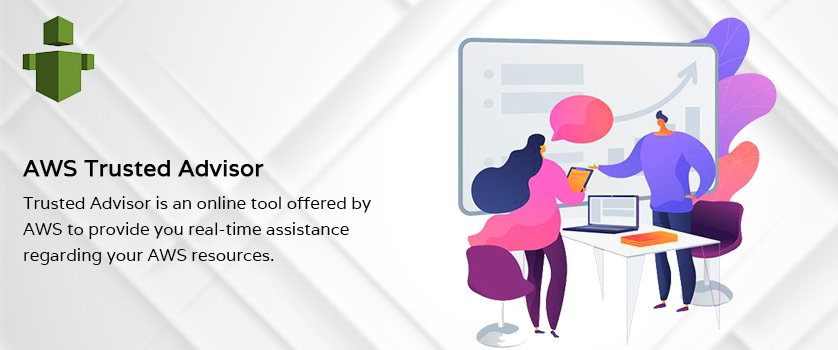
What Is AWS Trusted Advisor?
Trusted Advisor is an online tool offered by AWS to provide
you real-time assistance regarding your AWS resources. It
optimizes your AWS infrastructure, improves security and
performance, reduces your overall costs, and monitors service
limits. If you want to establish new workflows, develop
applications, or as part of ongoing improvement, take
advantage of the recommendations provided by Trusted Advisor
on a regular basis to help keep your solutions provisioned
optimally.
Features of AWS Trusted Advisor:
-
Email Notifications:
To help you stay up-to-date with a summary of status across
your checks, Trusted Advisor provides you notification
features. It notifies you weekly via email when you opt in
for this feature. A refresh of checks is required to ensure
an up-to-date summary of check status in your email
notification.
-
Recent Changes:
AWS Management Console dashboard lets you track recent
changes or check the status in the AWS. You can see the most
recent changes at the top of the list. However, this feature
is available with AWS Business Support and AWS Enterprise
Support.
-
Exclude Items:
This feature helps you with customization. By choosing
"exclude items", you can customize the Trusted Advisor
report. If you think that some items from the check result
are irrelevant, you can exclude those items. Since the
excluded items appear separately, you can restore (include)
them at any time.
-
Action Links:
Items in a Trusted Advisor report have hyperlinks to the
console, where you can take action on the Trusted Advisor
recommendations.
-
Access Management: You can use AWS Identity and Access Management (IAM) to
control access to specific checks or check categories.
-
AWS Support API:
By using AWS Support API, you can refresh and retrieve
Trusted Advisor results programmatically. Although this
feature is also available with AWS Business Support and AWS
Enterprise Support.
-
Refresh:
If you want to refresh individual checks or refresh all the
checks at once, you can do it by clicking the Refresh All
button in the top-right corner of the summary dashboard. The
minimum refresh interval varies based on the check.
-
Amazon CloudWatch Integration:
By integrating Amazon CloudWatch Events, you can detect and
react to changes in the status of Trusted Advisor checks.
But you can use this feature only if you have AWS Business
Support and AWS Enterprise Support.
Benefits of AWS Trusted Advisor:
-
Cost Optimization:
AWS Trusted Advisor helps you discover unused or idle
resources, which can be used optimally. Once you are aware
of the resources that are costing you and still of no use,
you can eliminate them or use them strategically. This way
you can save your money. For example, Idle Load Balancers
identify load balancers that are either not connected to any
back-end instances or handling extremely low traffic.
-
Performance:
Sometimes your organization might be using some resources
explicitly for a longer period of time. Since it impacts the
performance and still continues to happen due to negligence,
such practices need serious attention. AWS Trusted Advisor
checks your service limits and ensures better performance.
For example, High Utilization Amazon EC2 Instances checks
the CPU utilization during the previous two weeks and sends
alerts if daily utilization exceeds 90% for more than three
days, as consistently high utilization can lead to
application performance issues.
-
Security:
Loopholes in the technology can pose serious threats to the
security of an application. Hence, AWS Trusted Advisor
monitors the security of your application by closing gaps,
enabling various AWS security features, and examining your
permissions. For example, MFA on Root Account checks if
multi-factor authentication (MFA) has been enabled or not on
a root account, as enabling MFA on root accounts, enhances
security.
-
Fault Tolerance:
AWS Trusted Advisor can increase the availability and
redundancy of your AWS application by taking advantage of
auto-scaling, health checks, multi-AZ, and backup
capabilities. For example, Amazon RDS Multi-AZ checks if the
DB instance has been deployed in a single availability zone.
In such cases, a DB failure will cause an outage because of
a lack of high availability. Alternatively, a
high-availability setup resumes operating from the standby
database without any disruption to the business.
-
Service Limits:
AWS Trusted Advisor checks for service usage that is more
than 80% of the service limit. This way it increases the
overall performance of the AWS application on the
cloud.
Case Study:
At Hungama Digital Media Entertainment Pvt. Ltd., some of the
EC2 instances were highly over-provisioned and underutilized.
Plus, some of the test servers were never shut down after the
completion of special projects. Checks on EBS volumes showed
similar findings that identified underutilized EBS volumes
used for test projects.
To correct all these inaccuracies while handling the
resources, the organization used AWS Trusted Advisor to
perform cost optimization audits on Amazon EC2 instances and
Amazon EBS volumes in the company’s environment. As a
result, company was able to:
-
Do optimization exercise, where many volumes were deleted
and snapshots were saved on Amazon S3.
-
Shut down test servers automatically during lean hours and
the over-provisioned servers were adjusted to a more
efficient size.
Conclusion:
AWS Trusted Advisor is one of the reasons that will woo you
to choose AWS for your cloud environment needs. You must have
heard that most of the cloud vendors take care of the
maintenance of the online servers, but AWS Trusted Advisor
helps you cut down your expenses, which you might be bearing
because of negligence.


